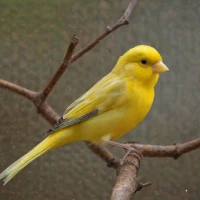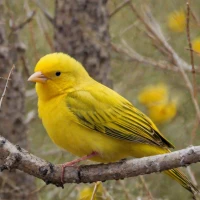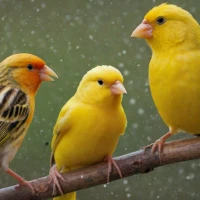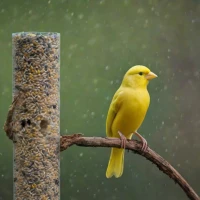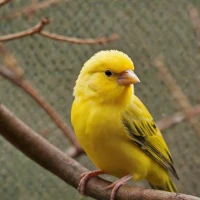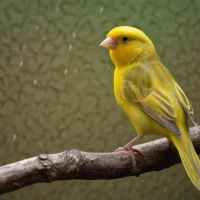The Joy of Breeding Canaries: A Closer Look at the Varieties and Their Unique Traits
Birds have always captivated me, and few are as delightful and enchanting as canaries. I remember, as a kid, spending endless afternoons in my grandmother’s sunlit porch. She had this enchanting cage, filled with bright yellow feathered friends – canaries of course. The cheerful melodies they sang infused our days with pure joy and warmth, and those memories ignited my passion for avian wonders.
The Alluring World of Canaries
What’s fascinating about canaries isn’t just their melodious songs but their incredible variety. Did you know there are over 200 breeds of canaries, each with its own charm and peculiar characteristics? I have to say, diving into the world of canary breeding is like stepping into a vibrant kaleidoscope – it’s absolutely spellbinding.
Understanding Canary Varieties
Color Canaries
Color canaries are bred primarily for their hues. They’re more than just yellow – think rich reds, deep oranges, and even sophisticated whites. The first time I saw a red-factor canary, I was floored. Such an intense, fiery red, it reminded me of autumn leaves blazing under the setting sun. The sight was unforgettable, and I knew I had to breed these wondrous little creatures.
Type Canaries
Type canaries are bred for their body shape and size. The Lizard Canary, with its unique, scale-like markings, stands out in this category – it’s like a bird straight out of a fairy tale. And then there’s the Border Canary, also affectionately known as the “Wee Gem” due to its rounded, compact form. My nephew always laughs and calls them the puffballs – a fitting nickname, really.
Song Canaries
Song canaries are all about the music they bring. The Waterslager Canary, known for its bubbling-like song, creates a melodic ambiance that can transport you to a creekside. I’ve always marveled at how these little birds can produce such intricate tunes – a symphony in a small package, if you will.
The Breeding Process: Patience and Passion
Breeding canaries is no walk in the park, but it’s a labor of love. Patience, precision, and a deep understanding of their needs are key. It’s akin to crafting a masterpiece, with each bird bringing a distinct brushstroke to the canvas.
Setting Up the Environment
First, the environment. Canaries need a spacious, clean cage with ample light – natural light is best. A fond memory comes to mind: setting up a new aviary with my friend, Tom. We were like two kids in a candy store, arranging perches, nesting materials, and ensuring everything was just right.
Nutrition and Health
Nutrition is paramount. A varied diet, including seeds, fresh fruits, and greens, keeps them healthy. I once had a canary, Chirp, who adored apples. The sound of her pecking at the fruit was a little melody in itself. It’s also essential to include a cuttlebone for calcium – think of it as a power snack.
Encouraging Breeding
Canaries typically breed in the spring when the days get longer. I remember one spring, eagerly watching my canaries, eager to see signs of nesting. Nesting cups and soft materials are crucial – cotton, shredded paper, even bits of fabric. Seeing the tiny birds industriously build their nests is always a heartwarming sight.
Challenges and Solutions in Canary Breeding
Infertility Issues
One challenge often faced is infertility. It’s disheartening, but not uncommon. Ensuring a balanced diet, ample sunlight, and lessening stress factors can help. I recall spending hours researching and tweaking the diet for my birds, and the payoff was worth it.
Aggression During Mating
Aggression can also be an issue. Sometimes, canaries don’t get along. Providing ample space and introducing them slowly helps. Imagine introducing new roommates – they need time to acclimate.
A Symphony of Success
Breeding canaries, through its ups and downs, feels like conducting a delicate symphony. Each success, marked by the chirping of newborn chicks, is a high note that resonates with joy. One memorable moment was when my daughter, Lily, first saw a chick hatch. Her eyes sparkled with wonder, and that memory is etched in my heart forever.
Interesting Facts About Canary Breeding
Here’s a juicy tidbit – did you know that the canary’s name isn’t derived from their color but from the Canary Islands, which in turn were named after dogs (Canaria in Latin), not the birds? Quite the twist, huh?
Overall, The Heart and Harmony of Canary Breeding
Finally, breeding canaries isn’t just about creating eye-catching birds or enchanting songs. It’s about the connection we form with these feathery enchanters. Through every chirp, flutter, and melody, they weave themselves into the tapestry of our lives, bringing color, joy, and a touch of wild charm to our everyday.
Thank you for taking the time to read about my journey with canaries. Have a chirpy day! 🌼



